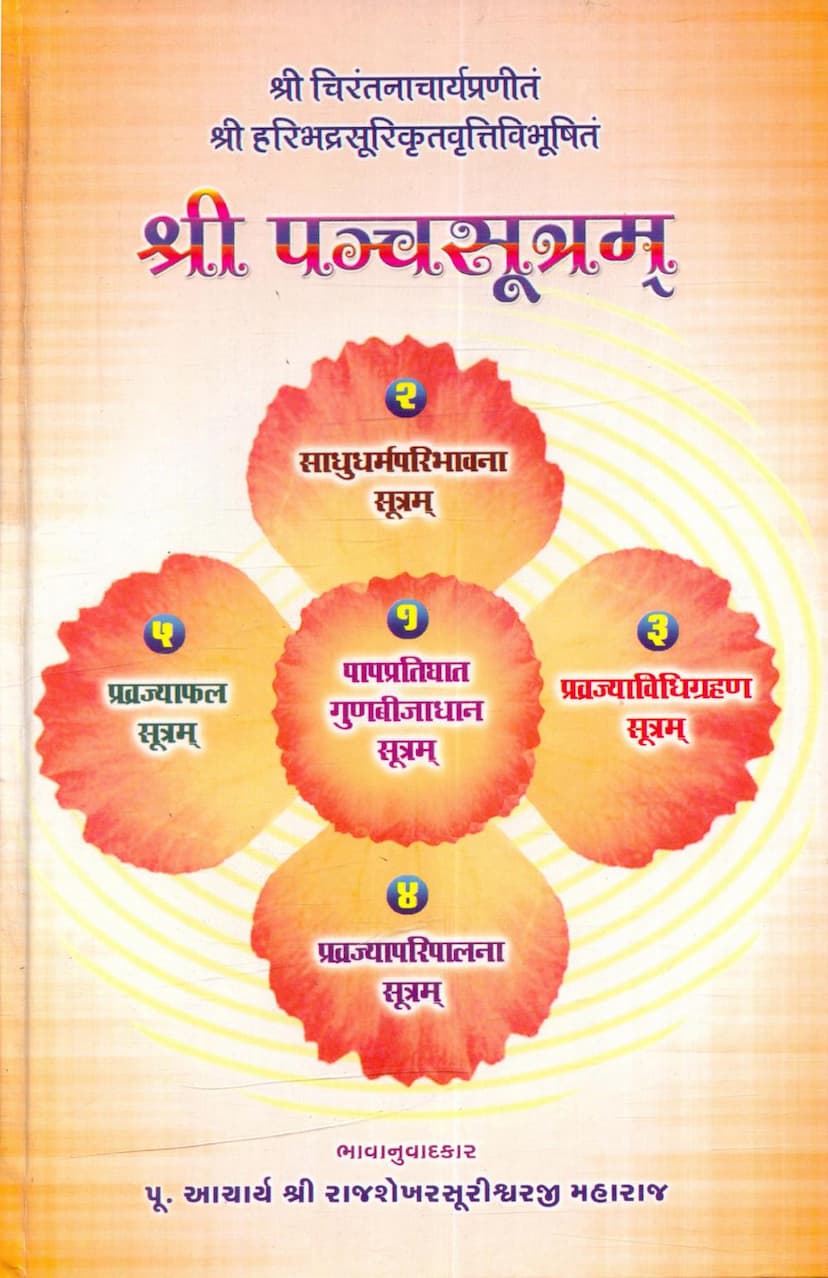Panch Sutram
Added to library: September 2, 2025

Summary
The Jain text "Panch Sutram" by Acharya Rajshekharsuri and Muni Dharamshekharvijay is a commentary and translation of an ancient Jain text originally composed by Chirantanacharya and elaborated with a Sanskrit commentary by Acharya Haribhadrasuri. The book, published by Arihant Aradhak Trust, serves as a guide to Jain spiritual practice, focusing on the path to liberation.
The "Panch Sutram" is structured into five key "sutras" or aphorisms, each addressing a crucial aspect of the spiritual journey:
-
Pāpa Pratighāta Guṇa Bījādhāna Sūtra (पापप्रतिघात गुणबीजाधान सूत्रम्): This first sutra, often referred to as the "Mangaḷa Sūtra" (auspicious sutra), emphasizes the essential first step of cleansing the soul from negative karma ("pāpa pratighāta") to prepare it for the reception of virtues ("guṇa bījādhāna"). It details the importance of taking refuge in the Arihants, Siddhas, Sadhus, and Dharma. It highlights the destruction of sins through repentance and condemnation of past wrongdoings ("duṣkṛta garhā") and the planting of seeds of virtue through auspicious actions and acceptance of the four refuges. This sutra serves as the foundation for all subsequent spiritual progress, likening the soul to a dirty vessel that must be thoroughly cleaned before being filled with fragrance.
-
Sādhu Dharma Paribhāvanā Sūtra (साधुधर्मपरिभावना सूत्रम्): This sutra focuses on cultivating a deep inclination and understanding towards the monastic way of life ("sādhu dharma"). It explains that after purifying the soul, one must develop a strong desire and resolve to follow the path of monks, which involves the highest forms of knowledge, perception, and conduct. This "paribhāvanā" (cultivation/deep contemplation) involves understanding the duties of a monk, appreciating their significance, and ultimately embracing the five vows of a monk, albeit in a partial form initially, as a preparation for full renunciation.
-
Pravrajyā Vidhi Grahaṇa Sūtra (प्रवज्याविधिग्रहण सूत्रम्): This sutra details the proper procedure for accepting monastic initiation ("pravrajyā"). It emphasizes that after developing a strong inclination and understanding of monastic life, one must formally accept the path with joy and devotion. This involves seeking permission from parents after convincing them and arranging for their livelihood. If parents are unwilling, it uses analogies like leaving sick parents to fetch medicine to illustrate the necessity of detachment from worldly ties, including family, for the sake of spiritual liberation. The sutra also outlines the ritualistic aspects of initiation and the importance of proper conduct during the process.
-
Pravrajyā Paripālanā Sūtra (प्रवज्यापरिपालना सूत्रम्): This sutra addresses the diligent practice and adherence to monastic vows after initiation ("pravrajyā paripālanā"). It highlights that a monk dedicated to the discipline of restraint ("saṃyama") can experience bliss surpassing even heavenly pleasures within a year. However, achieving this state requires adherence to prescribed methods, respect for the guru, diligent study of scriptures, and understanding the consequences of actions (both adherence and transgression). It stresses the importance of avoiding anything that might hinder spiritual progress and maintaining unwavering devotion to the spiritual path.
-
Pravrajyā Phala Sūtra (प्रवज्याफल सूत्रम्): This final sutra describes the ultimate fruit of observing monastic life – liberation ("moksha"). It explains that by controlling new karmas ("saṃvara") and shedding past karmas ("nirjarā"), the soul becomes free from karma and attains its pure, eternal state at the highest point of the universe ("lokāgra"). This state of liberation is characterized by absolute freedom from desires, pain, and suffering, leading to eternal bliss. The sutra provides a profound and logical discussion on the ultimate nature of liberation, emphasizing the cessation of worldly suffering and the attainment of the soul's inherent omniscient and omnipotent nature.
Throughout the text, the importance of the guru's guidance, the purity of intention, and the step-by-step progression through these five aspects of the spiritual path are consistently emphasized. The book also includes detailed explanations of the benefits derived from adhering to these principles, illustrating the profound wisdom of the ancient Jain Acharyas. The Gujarati translation and commentary by Acharya Rajshekharsuri aim to make this profound knowledge accessible to a wider audience, fostering spiritual growth and understanding.